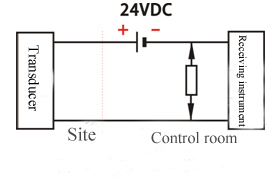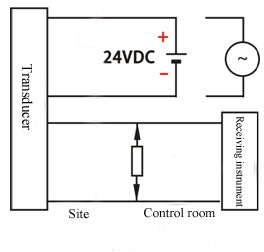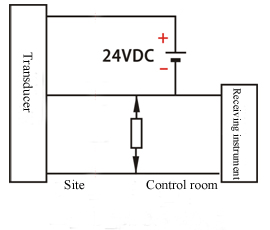2-Wire/3-Wire/4-Wire in Pressure Transducer Wiring
The 2-wire, 3-wire, and 4-wire of the pressure transducer refer to the wiring of the transducer. This title appeared only after the birth of the two-wire pressure transducer. It is the result of the widespread use of electronic amplifiers in the measurement of pressure sensors. The essence of amplification is an energy conversion process, which is inseparable from the power supply. Therefore, the first to appear is the four-wire pressure transducer. In this system, two wires are responsible for the supply of power, and the other two wires are responsible for outputting converted and amplified signals (such as voltage, current, etc.). The appearance of the electric unit combination meter made the four-wire pressure transducer has been widely used. The transducer’s power supply is 220VAC, and the output signal is 0-20mA DC.
I. The principle of 2-wire pressure transducer
In fact, with the development of technology, the product range and application fields of two-wire pressure transducers are becoming more and more extensive. Pressure transducers used in industrial production are also mostly two-wire.
Pressure transducers must meet the following conditions to achieve two-wire wiring
In the formula, E_min is the minimum supply voltage. For most instruments, Emin=24×(1%-5%)=22.8V. The 5% is negative change allowed by 24V power supply.
Imax=20mA
Imin=4mA
RLmax=250Ω+Resistance of the transport wire
If the pressure transducer have meet the above three conditions in design, a two-wire transmission can be achieved. Two-wire system means that the power supply and the load are connected in series, and there are a limited number of common points. At the production site, the signal connection and power supply between the pressure transducer and the control room meter use only two wires. These two wires are both power and signal lines. The two-wire system also facilitates the use of safety barriers for safety and explosion protection.

As shown in the figure, the two-wire pressure transducer is powered by 24VDC, the output signal is 4-20mA, and the load resistance is 250Ω. The 24V power supply has the lowest electric potential of negative line, which is the signal common line.
II. The principle of 4-wire pressure transducer
Due to the popularity and application of the 4-20 mA DC (1-5 V DC) signal system, in order to facilitate the connection in the control system application, the signal system is required to be unified. Therefore, for some instruments that are not combined with electric units, such as online analysis, mechanical quantity, power, etc., it is required to adopt a signal system with 4-20 mA output. However, due to the complexity of the conversion circuit and the large power consumption, it is difficult to fully satisfy the above three conditions. Therefore, the two-wire system cannot be realized, and only the external power supply method can be used, which produces a four-wire transducer with an output of 4-20 mA DC.

As shown in the figure, the power supply of the four-wire transducer is mostly 220V AC, and some transducers have 24V DC. The output signal is 4-20mA DC and the load resistance is 250Ω. There are also 0-10mA output signal and 0-1.5kΩload resistance. Some transducers also have V and mV signals, but the value of the load resistor or input resistor varies depending on the form of the output circuit.
III. The principle of 3-wire pressure transducer
In order to reduce the volume and weight of the pressure transducer, and improve the anti-interference performance as well as simplify wiring, the power supply of the pressure transducer is changed from 220V AC to low voltage DC. For example, the power supply is taken from a 24V DC power box, and the low voltage supply creates conditions for negative line sharing. Therefore, it produces the three-wire pressure transducer.

As shown in the figure, the three-wire of the three-wire transducer is that one wire used for the positive end of the power supply. One wire for the positive end of the signal output. The negative end of the power supply and the negative end of the signal are sharing one wire. Most of its power supply is 24V DC. The output signal is 4-20mA DC and the load resistance is 250Ω. There are also 0-10mA output signal and 0-1.5kΩload resistance. Some transducers also have V and mV signals, but the value of the load resistor or input resistor varies depending on the form of the output circuit.
In the above three figures, is the current signal that be input to the receiving instrument. If the resistor RL is connected in parallel, the voltage signal is received.
As can be seen from the above, due to the different working principles and structures of various pressure transducers, different products have emerged. It also determines the two-wire, three-wire and four-wire wiring of the pressure transducer. For the user, the selection for pressure transducer should according to the actual situation, such as the unified signal system, requirements of the receiving equipment, investment and other issues.
It should be noted that for three-wire and four-wire pressure transducers that output 4-20 mA signals, the output circuit structure is different from the two-wire system. Therefore, in the application, it is necessary to consider whether the output negative terminal can be connected to the negative line of the 24V power supply, and whether it can be grounded. Separation devices can be used when necessary. To avoid additional interference for the pressure transducer, we can use signal isolators, safety barriers, etc., in order to share power and ground with other instruments.
I. The principle of 2-wire pressure transducer
In fact, with the development of technology, the product range and application fields of two-wire pressure transducers are becoming more and more extensive. Pressure transducers used in industrial production are also mostly two-wire.
Pressure transducers must meet the following conditions to achieve two-wire wiring
- For the output voltage of the pressure transducer, calculation method for this value V as follows: the nominal minimum supply voltage minus the pressure drop value of the current at the load resistance and transmission line resistance. The formula is: V ≤ Emin-Imax×RLmax
- The normal operating current I of the pressure transducer must be less than or equal to the output current of the transducer. That is: I ≤Imin
- The small power consumption P of the pressure transducer cannot exceed the value of the following formula, and is usually P < 90 mW.
In the formula, E_min is the minimum supply voltage. For most instruments, Emin=24×(1%-5%)=22.8V. The 5% is negative change allowed by 24V power supply.
Imax=20mA
Imin=4mA
RLmax=250Ω+Resistance of the transport wire
If the pressure transducer have meet the above three conditions in design, a two-wire transmission can be achieved. Two-wire system means that the power supply and the load are connected in series, and there are a limited number of common points. At the production site, the signal connection and power supply between the pressure transducer and the control room meter use only two wires. These two wires are both power and signal lines. The two-wire system also facilitates the use of safety barriers for safety and explosion protection.

As shown in the figure, the two-wire pressure transducer is powered by 24VDC, the output signal is 4-20mA, and the load resistance is 250Ω. The 24V power supply has the lowest electric potential of negative line, which is the signal common line.
II. The principle of 4-wire pressure transducer
Due to the popularity and application of the 4-20 mA DC (1-5 V DC) signal system, in order to facilitate the connection in the control system application, the signal system is required to be unified. Therefore, for some instruments that are not combined with electric units, such as online analysis, mechanical quantity, power, etc., it is required to adopt a signal system with 4-20 mA output. However, due to the complexity of the conversion circuit and the large power consumption, it is difficult to fully satisfy the above three conditions. Therefore, the two-wire system cannot be realized, and only the external power supply method can be used, which produces a four-wire transducer with an output of 4-20 mA DC.

As shown in the figure, the power supply of the four-wire transducer is mostly 220V AC, and some transducers have 24V DC. The output signal is 4-20mA DC and the load resistance is 250Ω. There are also 0-10mA output signal and 0-1.5kΩload resistance. Some transducers also have V and mV signals, but the value of the load resistor or input resistor varies depending on the form of the output circuit.
III. The principle of 3-wire pressure transducer
In order to reduce the volume and weight of the pressure transducer, and improve the anti-interference performance as well as simplify wiring, the power supply of the pressure transducer is changed from 220V AC to low voltage DC. For example, the power supply is taken from a 24V DC power box, and the low voltage supply creates conditions for negative line sharing. Therefore, it produces the three-wire pressure transducer.

As shown in the figure, the three-wire of the three-wire transducer is that one wire used for the positive end of the power supply. One wire for the positive end of the signal output. The negative end of the power supply and the negative end of the signal are sharing one wire. Most of its power supply is 24V DC. The output signal is 4-20mA DC and the load resistance is 250Ω. There are also 0-10mA output signal and 0-1.5kΩload resistance. Some transducers also have V and mV signals, but the value of the load resistor or input resistor varies depending on the form of the output circuit.
In the above three figures, is the current signal that be input to the receiving instrument. If the resistor RL is connected in parallel, the voltage signal is received.
As can be seen from the above, due to the different working principles and structures of various pressure transducers, different products have emerged. It also determines the two-wire, three-wire and four-wire wiring of the pressure transducer. For the user, the selection for pressure transducer should according to the actual situation, such as the unified signal system, requirements of the receiving equipment, investment and other issues.
It should be noted that for three-wire and four-wire pressure transducers that output 4-20 mA signals, the output circuit structure is different from the two-wire system. Therefore, in the application, it is necessary to consider whether the output negative terminal can be connected to the negative line of the 24V power supply, and whether it can be grounded. Separation devices can be used when necessary. To avoid additional interference for the pressure transducer, we can use signal isolators, safety barriers, etc., in order to share power and ground with other instruments.

